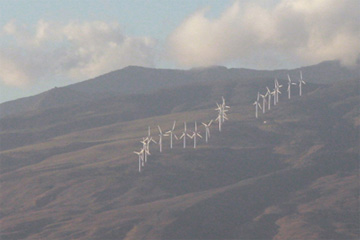A very hairy paper from three Harvard Grad students purports to show that especially the USA, Canada and China have all the wind power that we need to generate all the electricity we currently need. The rest of the world does too but not within it’s own confines. In other words some areas like say the Tibetan Uplands have way more than they need and maybe landlocked Germany does not. So they would have to trade but the net wind power to generate the electricity exists according to:
Xi Lu, Michael McElroy, and Juha Kiviluoma in:
IN the Proceedings of the National Academy of Sciences of the United States of America – I tend to believe these guys-
But all I can show you here is the abstrat because the 6 page paper is in PDF:
Global potential for wind-generated electricity
+Author Affiliations
-
Communicated by James G. Anderson, Harvard University, Cambridge, MA, April 29, 2009 (received for review November 6, 2008)
Abstract
The potential of wind power as a global source of electricity is assessed by using winds derived through assimilation of data from a variety of meteorological sources. The analysis indicates that a network of land-based 2.5-megawatt (MW) turbines restricted to nonforested, ice-free, nonurban areas operating at as little as 20% of their rated capacity could supply >40 times current worldwide consumption of electricity, >5 times total global use of energy in all forms. Resources in the contiguous United States, specifically in the central plain states, could accommodate as much as 16 times total current demand for electricity in the United States. Estimates are given also for quantities of electricity that could be obtained by using a network of 3.6-MW turbines deployed in ocean waters with depths <200 m within 50 nautical miles (92.6 km) of closest coastlines.
Footnotes
- 1To whom correspondence should be addressed. E-mail: mbm@seas.harvard.edu
-
Author contributions: X.L. and M.B.M. designed research; X.L. and M.B.M. performed research; X.L., M.B.M., and J.K. analyzed data; and X.L., M.B.M., and J.K. wrote the paper.
-
The authors declare no conflict of interest.
-
Freely available online through the PNAS open access option.
:}
They have pretty pictures too.
For a not so bad summary:
Wind could power the entire world
Jeremy Hance
mongabay.com
June 22, 2009
Wind power may be the key to a clean energy revolution: a new study in the Proceedings of the National Academy of Science finds that wind power could provide for the entire world’s current and future energy needs.
To estimate the earth’s capacity for wind power, the researchers first sectioned the globe into areas of approximately 3,300 square kilometers (1,274 square miles) and surveyed local wind speeds every six hours. They imagined 2.5 megawatt turbines crisscrossing the terrestrial globe, excluding “areas classified as forested, areas occupied by permanent snow or ice, areas covered by water, and areas identified as either developed or urban,” according to the paper. They also included the possibility of 3.6 megawatt offshore wind turbines, but restricted them to 50 nautical miles off the coast and to oceans depths less than 200 meters.
Using this criteria the researchers found that wind energy could not only supply all of the world’s energy requirements, but it could provide over forty times the world’s current electrical consumption and over five times the global use of total energy needs.
Turning to the world’s two largest carbon emitters, China and the United States, the researchers found that wind power has the potential to easily supply both nations.
|
Windmill for pumping water in Kenya  Wind turbines for power generation in Maui. |
“Large-scale development of wind power in China could allow for close to an 18-fold increase in electricity supply relative to consumption reported for 2005,” the researchers write. “The bulk of this wind power, 89%, could be derived from onshore installations. The potential for wind power in the U.S. is even greater, 23 times larger than current electricity consumption, the bulk of which, 84%, could be supplied onshore.”
Expanding their view to the top ten carbon emitters, the researchers found that Russia, Canada, and the United States (in this order) had the greatest capacity for wind power. However, they note that much of the area available for wind power in Russia and Canada is far from any cities, making their construction costly. In addition, the authors note that the public may oppose wind turbines in particular areas, especially remote, ecologically sensitive regions. Still, they conclude that “despite these limitations, it is clear that wind power could make a significant contribution to the demand for electricity” in most high carbon emitting countries.
:}
http://sustainablog.org/2009/02/03/wind-energy-jobs-surpass-coal-mining-jobs/
Todd Woody reported last week that the wind energy industry now employs more people than coal mining. That is 85,000 jobs in wind – a 70% increase from 2007 – to coal mining’s 81,000 jobs.
http://greenwombat.blogs.fortune.cnn.com/2009/01/28/wind-jobs-outstrip-the-coal-industry/
:}
